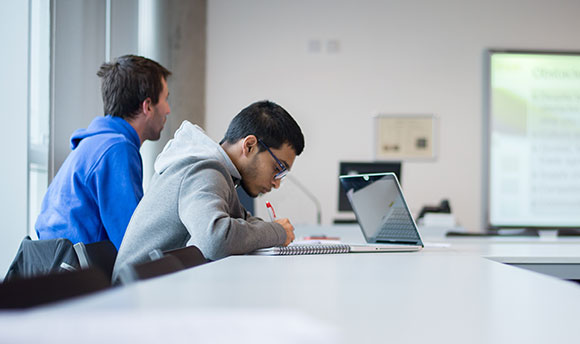Anti-Bullying and Harassment Policy
Queen Margaret University is wholly committed to fostering an environment in which all students, regardless of their background and personal circumstances should be treated with dignity, respect and fairness.
The University recognises that bullying and harassment can have a serious detrimental effect on the confidence, morale, performance and health of those affected, and may in extreme circumstances ultimately lead to students withdrawing from studies. The University believes that this situation should never be permitted to materialise and will treat all reports of bullying and harassment seriously.
The purpose of this policy is to promote a culture where bullying and harassment are acknowledged to be unacceptable and are not tolerated under any circumstances. Where allegations of such behaviour occur, this policy seeks to ensure that they are dealt with fairly, and in a timely fashion, without fear of victimisation.
The aim of this policy and procedure is to:
- Create and sustain a learning environment which is free from discrimination, bullying, harassment or victimisation;
- Tackle swiftly and effectively incidents of bullying, harassment or victimisation of, or by, students;
- Ensure that individuals are supported and encouraged in the event of any legitimate complaint;
- Establish that all members of the University - staff and students - are responsible for ensuring that individuals do not suffer any form of bullying or harassment;
- Safeguard the respect for students’ diverse talents, skills and experience;
- Promote the message that harassment, bullying or victimisation will not be tolerated in any form.
This policy applies to all students at Queen Margaret University, irrespective of whether an alleged incident takes place on University premises or elsewhere. All types of bullying and harassment, as described in this policy, are covered, whether or not the interactions have occurred between students and other students, or whether the allegations relate to students’ treatment by University staff. This policy covers face-to-face actions, as well as non-face-to-face interactions, for example email, written correspondence, social networking sites and text messages.
The University shall, where possible and appropriate, seek to ensure that partners have an equivalent policy in place.
All information gathered on individuals as part of the Anti-Bullying and Harassment Policy and Procedure will be processed in accordance with the Data Protection Act 2018.
Monitoring of the Bullying and Harassment policy will be undertaken by the University’s Governance and Quality Enhancement Team and Student Services.
The definition of harassment in the Equality Act 2010 is wide. It is ‘where a person (A) engages in unwanted conduct related to a relevant protected characteristic and the conduct has the purpose or effect of:
- violating another person's (B's) dignity, or
- creating an intimidating, hostile, degrading, humiliating or offensive environment for B’
It should be noted that 'unwanted' does not mean that express objection has to be made, and a serious one-off incident can amount to harassment.
It is important to note that differences of personality traits or culture and the misinterpretation of social signals can mean that what is perceived as harassment by one person may not seem so to another. The defining feature, however, is that the behaviour is offensive or intimidating to the recipient, and as such would be regarded as harassment by any reasonable person. It would need to be considered that, if the purpose of the conduct was to violate the individual’s dignity or create an intimidating, hostile, degrading, humiliating or offensive environment, then this is sufficient to establish harassment. However if harassment was not the purpose, but an individual argues that this was the effect of the conduct, the Equality Act says that in deciding whether conduct has that effect, consideration must be given to:
- the perception of the claimant;
- the other circumstances of the case; and
- whether it is reasonable for the conduct to have had that effect.
Forms of harassment involve offensive conduct or behaviour directed at a person’s racial origin, religion and beliefs (including non-belief), gender, disabilities, sexual orientation, age, family status (including their role as a carer or as a part-time worker, fixed term worker), marital status, political opinion, socio-economic status, or because he/she is a member of a trade union or similar associations or some other personal characteristic. It can also include the inappropriate use, or threat of use, of physical and mental power, authority or through social media.
With regard to religion and belief, it should be noted that there may be cultural differences which make some forms of behaviour generally regarded as acceptable by one group and unacceptable to another because such behaviour does not form part of the normal social interaction of that particular group.
Examples of potential harassment could be:
- Unwanted physical contact or physical attack.
- Offensive, suggestive or derogatory remarks, gestures, mockery, taunts, pranks, jokes, insults or ridicule; in person, on the telephone, by emails or social networking sites.
- Verbal abuse, threats or intrusive questioning.
- Insulting remarks based on the grounds of personal appearance or personal circumstances.
- Using an individual’s known disability to demoralise them.
- Leering at another individual’s body.
- Compromising invitations or gifts.
- Requests or demands for sexual favours.
- Circulation or displays of offensive, suggestive or degrading materials (such as pictures, graffiti or objects) in the teaching, learning, living or working environment.
- Sending of unwanted messages via e-mail and social networking sites.
- Ridicule for cultural differences such as appearance, dress, diet, religion or ethnic background.
- Subjecting an individual to group pressure.
- Derogatory or belittling remarks in front of others regarding appearance, work or personal attributes.
- Deliberately or repeatedly ignoring someone.
- Unwarranted exclusions.
- Any comments which imply that gender, age, sexual orientation, disability, race or ethnic or national origins, religious or other belief impairs the individual’s ability to perform satisfactorily.
- Any other unwelcome physical, verbal or non-verbal conduct.
- Incitement to commit any such act.
Harassment may or may not be linked to discrimination and can be based on characteristics which are protected under the Equality Act 2010:
- Age
- Disability;
- Gender reassignment;
- Marriage or civil partnership;
- Pregnancy and maternity;
- Race;
- Religion and belief;
- Sex;
- Sexual orientation.
Discrimination can be direct, associative, perceptive or indirect. The table below defines these terms. It is important to remember that the legislation focuses on the outcome of the discriminatory behaviour over the motive or intent.
Concept Definition
Direct Discrimination
This occurs when an individual is treated less favourably than others are, or would be, treated in similar circumstances.
Associative Discrimination This occurs when an individual is treated less favourably than another because they are associated with a person who has a protected equality characteristic. This is a form of direct discrimination. The key point to note is that the person bringing the claim does not need to have the protected characteristic (i.e. the protected characteristic can belong to another person). It is sufficient that the treatment is because of a protected characteristic. A student may also be able to bring a claim for harassment in those situations.
Perceptive Discrimination
This occurs when the protected characteristic is a perceived characteristic which the individual does not actually have. An individual may also be able to bring a claim for harassment in those situations.
Indirect Discrimination
This occurs when a condition is applied equally to all students but one group is particularly disadvantaged, and this disadvantage cannot be justified as being necessary for the efficient running of the University.
Bullying is a particular form of personal harassment and may be characterised as offensive, intimidating, malicious or insulting behaviour, as abuse or misuse of power, position or knowledge through means intended to undermine, humiliate, denigrate or injure the recipient. It may be by an individual against an individual or involve groups of people. It may be obvious or it may be insidious (such as ignoring a person).
Bullying can result from a misuse of individual power derived from perceived superior status/position, physical strength or force of personality. It can also arise from the collective power that arises out of strength of numbers.
Bullying is normally characterised by the emergence of a pattern of behaviour however if one act is deemed serious enough, this could amount to bullying.
Examples of potential bullying could be:
- Threats;
- Abuse;
- Public humiliation;
- Ridicule;
- Repeated shouting or swearing at an individual;
- Undermining an individual; and
- Intimidating behaviour.
Victimisation is when an individual is treated less favourably than they would otherwise have been because:
- They have made a claim or complaint;
- They have helped someone else to make a claim by giving evidence or information; or
- It is known or suspected that they are contemplating bringing a complaint.
Under the Equality Act 2010, these are known as ‘protected acts’. If a member of the University treats a student less favourably because he or she has carried out a protected act, this could be regarded as unlawful victimisation. There must be a link between the student’s protected act and the resulting treatment of that student.
Where behaviour has been alleged that would amount to a serious criminal offence, e.g. physical or sexual assault, this should be immediately reported to the police.
In such cases, any resulting criminal proceedings would normally be expected to have been completed before the University will take action under this policy (although suspension via the Student Disciplinary Regulations may be considered appropriate, if necessary).
The presumption will always be that complaints are made in good faith and that the complainant genuinely believes that they have grounds for raising a grievance. All cases will be investigated on this basis. An unfounded complaint will not be considered as malicious unless a deliberate attempt to mislead or of dishonesty is shown. However, should an investigation reveal a complaint to be malicious, this will be treated seriously and may lead to disciplinary action against the complainant.
All complaints should be raised as soon as possible through one of the following procedures, ideally within 12 months. Where it can be demonstrated that circumstances have prevented the individual concerned from raising the complaint within this time frame, the University will consider whether to allow an extension to this time scale.
The Informal Procedure
Every effort should be made for parties to aim to resolve issues informally in the first instance. If a student feels that he or she is being bullied or harassed by another student or by a member of University staff, he or she is encouraged first of all to seek to try to resolve the matter informally. As a first step, the student should try to make it clear to the person causing
the offence that such behaviour is unacceptable, is unwelcome and should be stopped. This will sometimes be sufficient to put an end to the behaviour in question, as in some cases the person against whom the complaint is directed might be unaware that his or her behaviour had inadvertently caused offence. Where this is the case, it is likely that the inappropriate behaviour ceases quickly.
If students require any help or advice, they may consider approaching, for example, one of the following people:
- Their Personal Academic Tutor
- The Programme Leader
- A member of Student Services
- A trusted friend
- A supportive lecturer or any other member of academic staff
- The Students’ Union
The Formal Procedure
It is accepted that there may be instances where the nature of the complaint is too serious to be dealt with informally and it is necessary to undertake a formal investigation of the complaint from the outset. It may be that a student feels unable to approach the alleged bully or harasser informally from the outset, or that, due to the nature of the alleged conduct, this is not appropriate. Formal proceedings may also be appropriate where a previous attempt at an informal resolution has been unsuccessful.
The student involved should set out the complaint, in writing, to the University Secretary. Complaints can be raised individually or as part of a group acting together. The student may be required to attend a meeting to give their side of events.
An Investigating Officer will be appointed by the University Secretary to conduct an investigation into the alleged bullying or harassment.
Where the complaint is by a student regarding alleged behaviour by another student, the investigation will be carried forward under the Student Disciplinary Procedure. Where the complaint is by a student regarding alleged behaviour by a staff member, the investigation will be carried forward under the Staff Disciplinary Procedure, and will be overseen by a member of the Human Resources Team.
The purpose of the investigation, via either route, is for the University to establish a fair and balanced view of the facts relating to the complaint. The extent of investigation required will depend on the nature of the allegations and will vary from case to case. The Investigating Officer will conduct a full and thorough investigation as speedily as possible and document the results.
It is important that any student alleging bullying or harassment co-operates fully and promptly in any investigation. This will include providing details of the names of any relevant witnesses, disclosing any relevant documents to the investigating officer and attending investigative interviews if required.
The investigation may involve interviewing and taking statements from the student(s) and any staff member(s) involved and any witnesses, and/or reviewstaff member(s) involved and any witnesses, and/or review
- establish the nature and circumstances of the alleged offence or problem;
- allow the complainant to provide details of his or her version of events to the investigating officer; and
- take into account any personal or mitigating factors that may come to light during the investigation.
- Where the investigation is in relation to an allegation of bullying by a member of staff carried forward under the Staff Discipline Procedure, the decision on whether or not a complaint is upheld will be made by Human Resources.
After completing the investigation under the appropriate procedure, the investigating officer will provide the University Secretary with a report and recommendations arising from the investigation. On the basis of the report, the University Secretary will advise the complainant in writing whether the complaint is upheld or not upheld.
Once the investigation stage has been completed, and the complainant remains dissatisfied with the manner in which the complaint was addressed by the University, the complainant is entitled to appeal to the Scottish Public Ombudsman Service (SPSO).
The SPSO considers complaints from those who remain dissatisfied at the conclusion of the University’s procedure, for example on grounds of an administrative failure by the University.
The SPSO will not investigate complaints on the grounds that the student is dissatisfied with the outcome of the University’s investigation in itself – the SPSO can only look at complaints where the complainant is alleging a fault or maladministration in the process followed by the University.
The SPSO also cannot normally look at complaints where:
- Students have not gone all the way through the University’s procedures;
- It is more than 12 months after the student became aware of the alleged offensive behaviour being complained about; or
- The matter is being considered in court.
Contact details for the SPSO are as follows:
Freepost SPSO, SPSO, Bridgeside House, 99 McDonald Road, Edinburgh EH7 4NS
Opening hours: Monday, Wednesday, Thursday, Friday 9am–5pm, Tuesday 10am–5pm
SPSO freephone 0800 377 7330
Fax 0800 377 7331
























